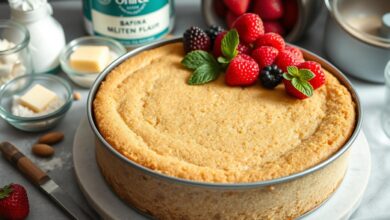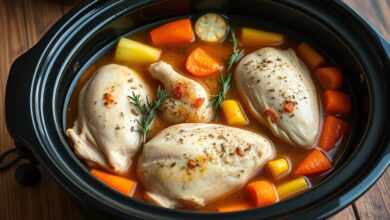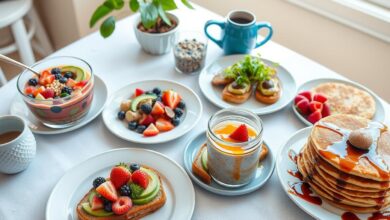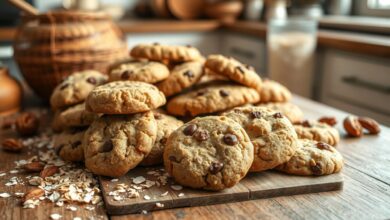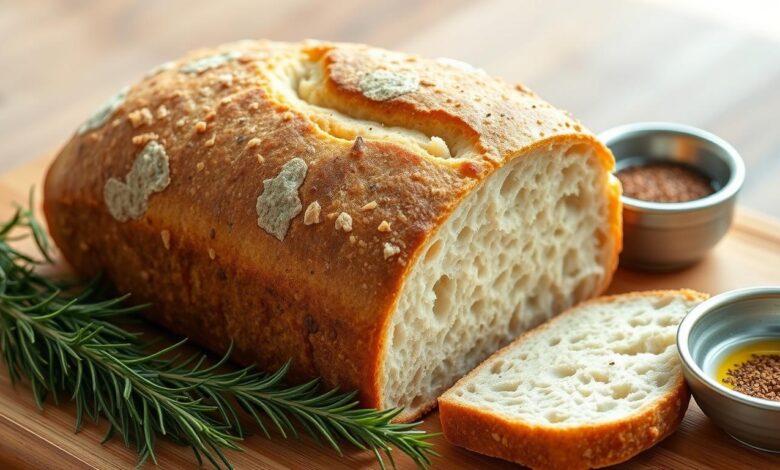
Bread Without Gluten: Delicious and Healthy Alternatives
Gluten sensitivities and dietary restrictions are on the rise. This means more people are looking for tasty, gluten-free bread. If you have celiac disease, gluten intolerance, or just prefer a wheat-free diet, this article is for you. It will show you how to enjoy delicious gluten-free bread that’s also good for you.
Table of Contents
Understanding the Need for Bread Without Gluten
The need for gluten intolerance options and dietary restriction breads is growing fast. More people are seeing the benefits of avoiding gluten. This has made gluten-free bread very popular.
What Makes Traditional Bread Off-Limits
Gluten, found in wheat, rye, and barley, is the main problem. It’s a protein that can cause issues for those with celiac disease, gluten sensitivity, or wheat allergies. Eating gluten can lead to digestive problems and even autoimmune reactions.
Health Benefits of Going Gluten-Free
Going gluten-free can improve digestion and reduce inflammation. It can also make people feel better overall. Gluten-free bread lets those with gluten issues enjoy bread without the negative effects.
Common Symptoms of Gluten Sensitivity
- Abdominal pain and bloating
- Diarrhea or constipation
- Fatigue and brain fog
- Headaches and migraines
- Skin rashes and eczema
- Joint and muscle pain
Knowing why traditional bread is not good for those with gluten issues is key. It opens the door to exploring gluten intolerance options and dietary restriction breads.
Essential Ingredients for Gluten-Free Baking
Creating delicious gluten-free bread starts with knowing the right ingredients. You’ll explore alternative flour blends and grain-free baking. This opens up a world of new flavors and textures.
Flours are at the core of gluten-free baking. You’ll use flours like almond, coconut, and ancient grains like quinoa. These flours give your bread structure and unique flavors.
You also need binders and leavening agents. Xanthan gum, psyllium husk, and chia seeds are common binders. Baking soda, baking powder, and yeast help your bread rise. Finding the right mix is crucial for the perfect texture.
| Ingredient | Purpose | Examples |
|---|---|---|
| Alternative Flours | Provide structure and texture | Almond flour, coconut flour, quinoa flour, amaranth flour |
| Binders | Help maintain shape and structure | Xanthan gum, psyllium husk, chia seeds |
| Leavening Agents | Cause the bread to rise and achieve the desired texture | Baking soda, baking powder, yeast |
With these ingredients, you’re ready to make amazing gluten-free bread. Try different flour blends and binders to find what you like best.
Popular Alternative Flours and Their Properties
Choosing the right flour is key for specialized bread recipes and allergen-free baked goods. There are many gluten-free flour options that can improve your baking. They cater to different dietary needs.
Almond and Coconut Flour Options
Almond flour and coconut flour are great for adding moisture and a nutty flavor. They are naturally gluten-free. They also offer healthy fats, fiber, and protein.
Rice and Tapioca Alternatives
Rice flour and tapioca flour are light and versatile. They help make gluten-free baked goods soft and airy.
Ancient Grain Flour Choices
Try flours from ancient grains like millet, buckwheat, and quinoa. They bring rich flavors and nutrients. They also add a unique texture to your breads.
| Flour Type | Unique Properties | Best Uses |
|---|---|---|
| Almond Flour | High in healthy fats, protein, and fiber | Cakes, cookies, breads, and pastries |
| Coconut Flour | Absorbent and adds moisture, fiber-rich | Baked goods, batters, and coatings |
| Rice Flour | Mild flavor, light and airy texture | Breads, crackers, and pasta |
| Tapioca Flour | Provides stretch and chewiness | Thickening agent, binders, and glazes |
| Millet Flour | Nutty flavor, high in protein and fiber | Breads, muffins, and baked goods |
| Buckwheat Flour | Earthy, robust flavor, nutrient-dense | Pancakes, crepes, and hearty breads |
| Quinoa Flour | Slightly bitter, high in protein | Breads, crackers, and baked snacks |
“Exploring the diverse world of gluten-free flours is a true culinary adventure, unlocking endless possibilities for delicious and nutritious allergen-free baked goods.”
Must-Have Kitchen Tools for Gluten-Free Bread Making
Making tasty gluten-free bread and wheat-free loaves at home needs more than basic tools. You’ll need special tools for the perfect texture and rise. Here are the key items to improve your gluten-free baking.
- Bread Pans: Get high-quality, non-stick pans for gluten-free bread. They’re often smaller to fit gluten-free doughs.
- Stand Mixer: A strong stand mixer with a paddle helps mix and knead. It’s great for wheat-free loaves that need extra effort.
- Digital Scale: Accurate measurements are key for gluten-free baking. A digital scale helps you get the right amounts for consistent results.
- Dough Scraper: This tool makes moving and shaping gluten-free bread dough easy. It prevents dough from sticking to your hands.
- Parchment Paper: Use parchment paper in your pans to prevent gluten-free loaves from sticking. It makes removing the bread easy.
| Tool | Purpose | Why It’s Essential |
|---|---|---|
| Bread Proofing Basket | Creates the perfect rise and crust for gluten-free bread. | Ensures the right texture and shape for your wheat-free loaves. |
| Dough Whisk | Mixes ingredients well in gluten-free bread dough. | Guarantees a smooth batter for consistent baking. |
| Bench Scraper | Helps shape and move gluten-free bread dough. | Allows for precise handling of delicate wheat-free loaves. |
With the right tools, you’ll be ready to bake amazing gluten-free bread and wheat-free loaves. They’ll be just as good as traditional breads.
Best Binding Agents for Perfect Texture
Getting the right texture in gluten-free bread and baked goods is key. Without gluten, bakers use other agents to get the right feel. Natural gums, stabilizers, and plant-based options help achieve the perfect texture in celiac-friendly bread and allergen-free baked goods.
Natural Gums and Stabilizers
Xanthan gum is a top pick for gluten-free baking. It keeps ingredients together and holds moisture. Psyllium husk also works well, improving the bread’s structure and texture.
Chia seeds and flaxseeds are great for binding. They create a gel-like texture when mixed with liquids.
Egg Substitutes and Alternatives
For those who need allergen-free baked goods, egg substitutes are a big help. Options like commercial egg replacers, mashed bananas, and aquafaba (canned chickpea liquid) are effective. They help get the right texture without eggs.
Plant-Based Binding Solutions
- Nut and seed butters, like almond or cashew butter, add richness and help bind gluten-free doughs.
- Pureed white beans or chickpeas make the dough soft and moist.
- Ground flaxseeds or chia seeds mixed with water create a gel that binds well.
Learning about these binding agents lets you experiment. You can find the perfect mix for your celiac-friendly bread and allergen-free baked goods.
Basic Techniques for Baking Wheat-Free Loaves
Learning to bake bread without gluten is a skill. It involves understanding how to work with different flours and ingredients. This knowledge helps you make tasty, satisfying grain-free baking creations.
Mixing is key. Gluten-free batters need more mixing to get right. Make sure to mix dry ingredients well before adding wet ones.
Don’t skip the rest time. Gluten-free breads need longer to rest. This lets the ingredients hydrate and relax, making the bread lighter.
Adjust your oven settings. Gluten-free breads bake best at 350°F to 375°F. They also need a bit more time in the oven. This ensures the inside cooks well without burning the crust.
| Technique | Recommendation |
|---|---|
| Mixing | Vigorous blending of dry and wet ingredients |
| Resting | Extended hydration and relaxation periods |
| Baking | Lower temperatures (350°F to 375°F) with longer times |
Mastering these basic techniques will help you bake amazing bread without gluten. Keep trying, watching, and tweaking your methods. This will help you perfect your grain-free baking recipes.
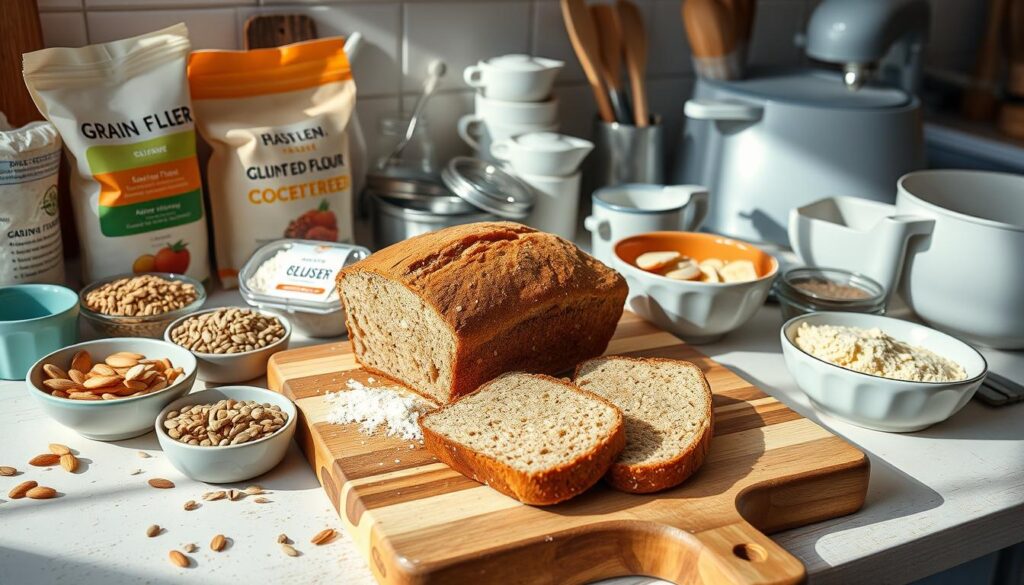
Troubleshooting Common Gluten-Free Baking Issues
Gluten-free bread baking can be tricky, but with the right tips, you can make great loaves. We’ll help you solve texture, rising, and density problems.
Addressing Texture Problems
Getting the right texture in gluten-free bread is a challenge. But with some tips, you can achieve a soft, springy crumb. Try adjusting your flour blends and using binding agents. Also, pay attention to kneading and proofing times to avoid dryness.
Fixing Rising and Density Issues
Gluten-free bread sometimes has trouble rising and getting the right texture. Use yeast, baking soda, and other agents to help it rise. Also, adjust the wet to dry ingredient ratio for a light, airy loaf.
Storage and Shelf Life Solutions
Gluten-free bread often has a short shelf life. To keep it fresh, store it in airtight containers or freeze slices. Try different packaging and storage methods to find what works best.
With a bit of troubleshooting and experimentation, you can master gluten-free bread baking. Keep these tips in mind, and your bread will be a hit with everyone.
Quick and Easy Celiac-Friendly Bread Recipes
If you’re on a gluten-free diet or have gluten intolerance, finding tasty bread can be tough. Don’t worry, we’ve got you covered. We’ve gathered quick and easy celiac-friendly bread recipes. They’re perfect for satisfying your cravings while meeting your dietary needs.
Gluten-Free Sandwich Bread
Want the classic taste and feel of sandwich bread without gluten? This recipe is for you. It mixes gluten-free flours like rice flour and tapioca starch. The result is a soft, airy loaf. It’s great for lunch or breakfast.
Fluffy Dinner Rolls
Looking for warm, fresh rolls for your meals? Our gluten-free dinner roll recipe is here. It uses almond flour and xanthan gum. These rolls are light and fluffy, even gluten-eaters will love them.
Garlic and Herb Focaccia
Want to make your gluten-free meals more exciting? Try our garlic and herb focaccia. It’s savory, crusty, and perfect with soups, salads, or as a snack.
| Recipe | Prep Time | Cook Time | Total Time |
|---|---|---|---|
| Gluten-Free Sandwich Bread | 15 minutes | 45 minutes | 1 hour |
| Fluffy Dinner Rolls | 20 minutes | 25 minutes | 45 minutes |
| Garlic and Herb Focaccia | 30 minutes | 35 minutes | 1 hour 5 minutes |
Craving a quick sandwich, soft dinner rolls, or savory focaccia? We’ve got you covered. Enjoy homemade gluten-free bread that’s easy to make and delicious.
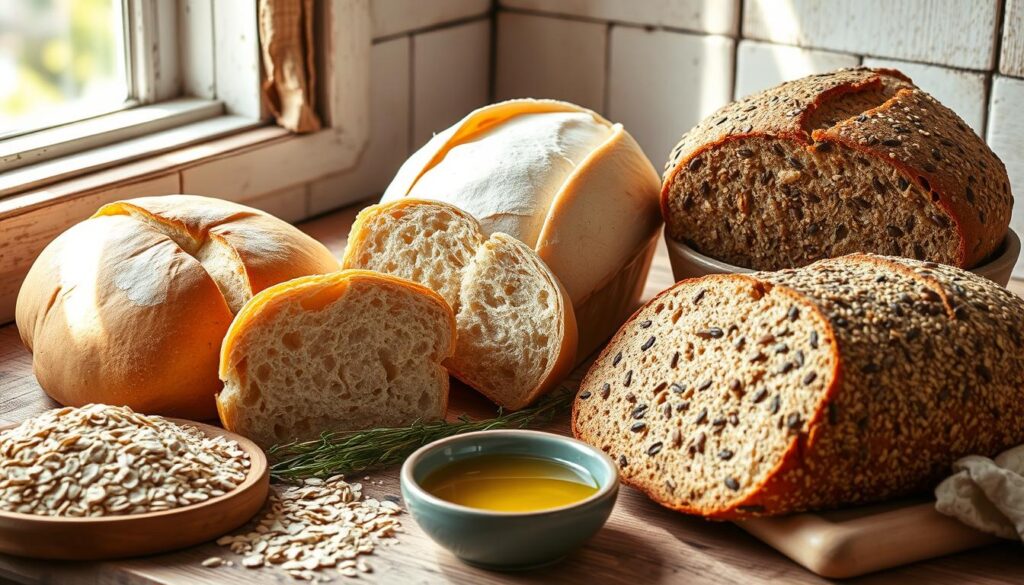
Advanced Tips for Artisanal Gluten-Free Breads
Take your gluten-free bread baking to the next level with these advanced tips. Learn how to make perfect crusts, achieve the right crumb texture, and boost the flavors in your wheat-free loaves.
Creating Perfect Crusts
To get a crispy crust on your gluten-free bread, try a few special tricks. First, preheat your oven to about 425°F (218°C). Then, bake your loaves on a preheated baking stone or steel. This high heat will make the crust golden and crunchy.
Also, mist the oven with water before baking to create steam. This helps the crust develop better. Brushing the dough’s top with egg white or milk before baking can make the crust glossy and well-defined.
Achieving Ideal Crumb Structure
Getting the right crumb texture in your alternative flour blends is key. Try using xanthan gum, psyllium husk, or flax meal to find the perfect balance. This will give your bread a light, airy, and even crumb.
Proper kneading and proofing are also important. Knead the dough well to activate the binding agents. Then, let it rise for a long time to fully expand the gluten-free structure.
Flavor Enhancement Techniques
Boost the flavor of your gluten-free breads with aromatic ingredients and techniques. Add a bit of honey, maple syrup, or molasses for sweetness. You can also try spices, herbs, or a splash of wine or beer for complex flavors.
Using a long, slow fermentation process can also enhance flavors. Proof the dough in the fridge for hours or overnight before baking. This lets the flavors meld together beautifully.
Store-Bought Options for Allergen-Free Baked Goods
When you can’t make gluten-free bread at home, there are great store-bought choices. Many brands offer allergen-free baked goods and dietary restriction breads. The selection has grown a lot in the last few years.
Choosing a pre-made allergen-free bread? Always check the ingredients. Look for products without gluten, dairy, and soy. Choose ones with simple, natural ingredients. Most grocery stores have gluten-free sections now, making it easier to find what you need.
| Brand | Bread Type | Key Ingredients | Dietary Considerations |
|---|---|---|---|
| Udi’s | Whole Grain Sandwich Bread | Tapioca starch, brown rice flour, eggs, apple cider vinegar | Gluten-free, dairy-free, nut-free |
| Canyon Bakehouse | Honey White Sandwich Bread | Tapioca starch, brown rice flour, honey, eggs | Gluten-free, dairy-free, nut-free |
| Schar | Artisan Baker White Bread | Rice flour, potato starch, eggs, rice starch | Gluten-free, dairy-free, soy-free |
Whether you have dietary restrictions or not, there’s a store-bought allergen-free bread for you. It’s a convenient choice when making your own isn’t possible.
Conclusion
Bread without gluten can be a tasty and healthy choice for those who avoid gluten. You’ve learned how to make gluten-free bread at home. This is great for those who need to avoid wheat flour.
Exploring different flours and baking methods opens up new possibilities. You can make bread that fits your dietary needs. The secret is to try new things and understand gluten-free ingredients.
If you’re new to gluten-free baking or already skilled, this article has helped you. You now have the knowledge to make delicious gluten-free bread. Let your creativity flow as you find your favorite gluten-free bread recipe.
FAQ
What makes traditional bread off-limits for those with gluten intolerance?
Traditional bread has gluten, which can cause problems for people with gluten issues. This includes celiac disease, non-celiac gluten sensitivity, and wheat allergies. Eating gluten can lead to digestive issues, bloating, and even damage to the small intestine.
What are the health benefits of going gluten-free?
Going gluten-free can help those with gluten-related disorders. It can reduce inflammation and improve digestion. You might also feel more energetic and have better gut health. It can also help manage symptoms of celiac disease and non-celiac gluten sensitivity.
What are some common symptoms of gluten sensitivity?
Symptoms of gluten sensitivity include bloating, gas, and abdominal pain. You might also experience diarrhea, constipation, fatigue, headaches, brain fog, and skin rashes. If you have these symptoms after eating gluten, see a healthcare professional for help.
What are the key ingredients needed for successful gluten-free baking?
For great gluten-free bread, you need alternative flours like almond, coconut, or rice. You also need starches, binders, and leavening agents. Xanthan gum, psyllium husk, and chia seeds are common binders that help with texture.
What are some popular alternative flour options for gluten-free baking?
There are many gluten-free flour options. You can choose from nut-based flours like almond and coconut, grain-based flours like rice and tapioca, and ancient grain flours like quinoa and teff. Each flour has its own characteristics and can be mixed to get the right texture and flavor.
What are some must-have kitchen tools for gluten-free bread making?
You’ll need a stand mixer, digital kitchen scale, and specialized bread pans for gluten-free baking. A proofing box or oven with a warm, humid environment is also key. These tools help you get the right consistency, rise, and texture in your gluten-free bread.
What are some common binding agents used in gluten-free baking?
Effective binding agents for gluten-free bread include xanthan gum and psyllium husk. You can also use egg substitutes and plant-based solutions like chia seeds and ground flaxseeds. These ingredients help with structure, elasticity, and moisture, mimicking gluten in traditional bread.
What are some basic techniques for baking wheat-free loaves?
For gluten-free bread baking, use proper mixing methods and resting times. Adjusting baking temperatures is also important. Gluten-free doughs need more mixing to develop structure, and careful proofing and baking temperatures are key for texture and rise.
How can I troubleshoot common gluten-free baking issues?
To fix common gluten-free bread baking issues, try adjusting ingredient ratios and using more binding agents. Experiment with different baking methods. Proper storage and handling can also help extend the shelf life of your gluten-free baked goods.
Where can I find quick and easy celiac-friendly bread recipes?
There are many simple and fast gluten-free bread recipes for those with celiac disease or gluten sensitivity. From sandwich loaves to dinner rolls, these recipes use alternative flours and binders to create delicious, safe breads.
What are some advanced techniques for creating artisanal gluten-free breads?
To improve your gluten-free bread baking, try advanced techniques like creating perfect crusts and achieving an open crumb structure. Use specialized ingredients and fermentation methods to enhance flavors. These techniques can help you make truly artisanal gluten-free breads.
What are some high-quality store-bought options for allergen-free baked goods?
If making gluten-free bread at home isn’t an option, there are many reputable brands offering pre-made, allergen-free baked goods. Look for sandwich breads, rolls, and specialty items. Always check the ingredient labels to ensure they meet your dietary needs and preferences.
